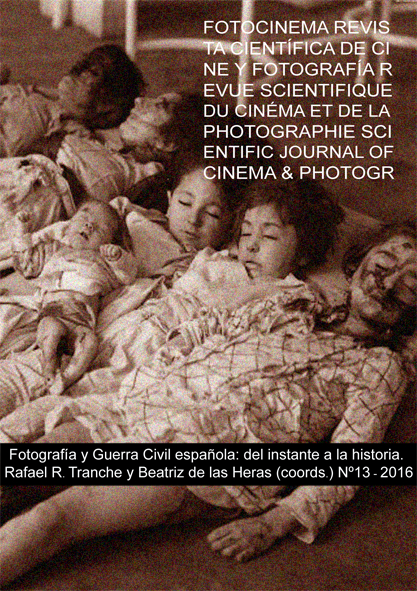La intimidad invisible. Fotografía e infancia en la Guerra Civil española
DOI:
https://doi.org/10.24310/Fotocinema.2016.v0i13.6054Abstract
La Guerra Civil Española supuso un nuevo modo de fotografiar una contienda: se ampliaron tanto la cantidad de imágenes como el repertorio de acontecimientos, adquiriendo la representación de la infancia singular importancia. También en la fotogra-fía doméstica, afianzada a mediados de los años 30, el niño comienza a ocupar un papel central como símbolo de la supervivencia familiar en medio de la catástrofe.Sin embargo, si examinamos el imaginario de la infancia que la guerra nos ha legado constataremos que hoy privilegiamos una serie limitada de imágenes entre las que la fotografía familiar parece no existir o se con-funde con las imágenes de la Historia. El pre-sente artículo se interroga acerca de esta indefinición y esta reducción, explicándolas por dos movimientos aparentemente opues-tos. En primer lugar, un agenciamiento de lo privado con fines políticos e ideológicos y, junto a este, una adecuación de la fotografía privada a códigos establecidos por fotografías de circulación pública, ya fueran informativas o propagandísticas en un paradójico círculo vicioso que ha limitado drásticamente nues-tro panorama visual memorial.
Abstract:
The Spanish Civil War was a new way of taking pictures in a conflict. It extended both the number of images and the subjects represented, where the childhood took a singular importance.
Also, in the family photography at the 30’s, the child started to be symbol of the family survival in the middle of the catastrophe.
Although, if we review the childhood’s imaginary, we will prove that today it is limited of a few images.
Between all these limited staff, family photography seems not to exist or it is mixed with the historical photography.
This paper questions this mixture, which it explains by a paradox: on one hand, it shows how the intimate image it is utilised whit ideological ends. On the other hand, the private images were adapted to the propaganda model of photography.Downloads
Metrics
Publication Facts
Reviewer profiles N/A
Author statements
Indexed in
-
—
- Academic society
- N/A
- Publisher
- Universidad de Málaga
Downloads
Published
How to Cite
Issue
Section
License
All contents published in Fotocinema Revista científica de cine y fotografía are protected under the Creative Commons Attribution-NonCommercial-ShareAlike 4.0 International (CC BY-NC-SA 4.0) license. All about this license is available in the following link: <http://creativecommons.org/licenses/by-nc-sa/4.0>
Users can copy, use, redistribute, share and exhibit publicly as long as:
- The original source and authorship of the material are cited (Journal, Publisher and URL of the work).
- It is not used for comercial purposes.
- The existence of the license and its especifications are mentioned.
There are two sets of authors’ rights: moral and property rights. Moral rights are perpetual prerogatives, unrenounceable, not-transferable, unalienable, imprescriptible and inembargable. According to authors’ rights legislation, Fotocinema. Revista científica de cine y fotografía recognizes and respects authors moral rights, as well as the ownership of property rights, which will be transferred to University of Malaga in open access. The property rights are referred to the benefits that are gained by the use or the dissemination of works. Fotocinema. Revista científica de cine y fotografía is published in an open access form and it is exclusively licenced by any means for doing or authorising distribution, dissemination, reproduction, , adaptation, translation or arrangement of works.
Authors are responsable for obtaining the necessary permission to use copyrighted images.














13.png)



